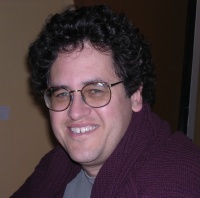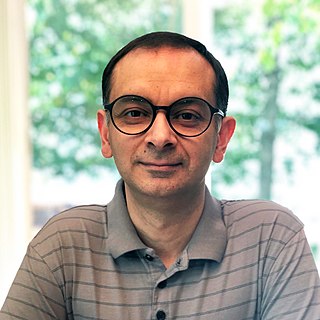External links
- Profile and research at the UNAM site.
- Abstract of an article on Loop Quantization of Maxwell Theory.
Alejandro Corichi is a theoretical physicist working at the Quantum Gravity group of the National Autonomous University of Mexico (UNAM). He obtained his bachelor's degree at UNAM (1991) and his PhD at Pennsylvania State University (1997). His field of study is General Relativity and Quantum Gravity, where he has contributed to the understanding of classical aspects of black holes, to the non-commutativity and black holes within the approach known as Loop quantum gravity and to loop quantum cosmology.
Quantum gravity (QG) is a field of theoretical physics that seeks to describe gravity according to the principles of quantum mechanics, and where quantum effects cannot be ignored, such as in the vicinity of black holes or similar compact astrophysical objects where the effects of gravity are strong, such as neutron stars.

A gravitational singularity, spacetime singularity or simply singularity is a location in spacetime where the density and gravitational field of a celestial body is predicted to become infinite by general relativity in a way that does not depend on the coordinate system. The quantities used to measure gravitational field strength are the scalar invariant curvatures of spacetime, which includes a measure of the density of matter. Since such quantities become infinite at the singularity point, the laws of normal spacetime break down.

Loop quantum gravity (LQG) is a theory of quantum gravity, which aims to merge quantum mechanics and general relativity, incorporating matter of the Standard Model into the framework established for the pure quantum gravity case. As a candidate for quantum gravity, LQG competes with string theory.

John Carlos Baez is an American mathematical physicist and a professor of mathematics at the University of California, Riverside (UCR) in Riverside, California. He has worked on spin foams in loop quantum gravity, applications of higher categories to physics, and applied category theory.
Lee Smolin is an American theoretical physicist, a faculty member at the Perimeter Institute for Theoretical Physics, an adjunct professor of physics at the University of Waterloo and a member of the graduate faculty of the philosophy department at the University of Toronto. Smolin's 2006 book The Trouble with Physics criticized string theory as a viable scientific theory. He has made contributions to quantum gravity theory, in particular the approach known as loop quantum gravity. He advocates that the two primary approaches to quantum gravity, loop quantum gravity and string theory, can be reconciled as different aspects of the same underlying theory. His research interests also include cosmology, elementary particle theory, the foundations of quantum mechanics, and theoretical biology.

Hawking radiation is black-body radiation that is predicted to be released by black holes because of quantum effects near the black hole event horizon. It is named after the physicist Stephen Hawking, who developed a theoretical argument for its existence in 1974.
Abhay Vasant Ashtekar is an Indian theoretical physicist. He is the Eberly Professor of Physics and the Director of the Institute for Gravitational Physics and Geometry at Pennsylvania State University. As the creator of Ashtekar variables, he is one of the founders of loop quantum gravity and its subfield loop quantum cosmology. He has also written a number of descriptions of loop quantum gravity that are accessible to non-physicists. In 1999, Ashtekar and his colleagues were able to calculate the entropy for a black hole, matching a legendary 1974 prediction by Hawking. Oxford mathematical physicist Roger Penrose has described Ashtekar's approach to quantum gravity as "The most important of all the attempts at 'quantizing' general relativity." Ashtekar was elected as Member to National Academy of Sciences in May 2016.

In physics, black hole thermodynamics is the area of study that seeks to reconcile the laws of thermodynamics with the existence of black-hole event horizons. As the study of the statistical mechanics of black-body radiation led to the advent of the theory of quantum mechanics, the effort to understand the statistical mechanics of black holes has had a deep impact upon the understanding of quantum gravity, leading to the formulation of the holographic principle.
Jorge Pullin is the Horace Hearne Chair in theoretical Physics at the Louisiana State University, known for his work on black hole collisions and quantum gravity.

The Big Bounce is a hypothesized cosmological model for the origin of the known universe. It was originally suggested as a phase of the cyclic model or oscillatory universe interpretation of the Big Bang, where the first cosmological event was the result of the collapse of a previous universe. It receded from serious consideration in the early 1980s after inflation theory emerged as a solution to the horizon problem, which had arisen from advances in observations revealing the large-scale structure of the universe. In the early 2000s, inflation was found by some theorists to be problematic and unfalsifiable in that its various parameters could be adjusted to fit any observations, so that the properties of the observable universe are a matter of chance. Alternative pictures including a Big Bounce may provide a predictive and falsifiable possible solution to the horizon problem, and are under active investigation as of 2017.

Rodolfo Gambini is a physicist and professor of the Universidad de la Republica in Montevideo, Uruguay and a visiting professor at the Horace Hearne Institute for Theoretical Physics at the Louisiana State University.

Gerardus (Gerard) 't Hooft is a Dutch theoretical physicist and professor at Utrecht University, the Netherlands. He shared the 1999 Nobel Prize in Physics with his thesis advisor Martinus J. G. Veltman "for elucidating the quantum structure of electroweak interactions".

Olaf Dreyer is a German theoretical physicist whose research interests include quantum gravity and the quantum measurement problem. Dreyer received his Ph.D. in quantum gravity in 2001 from the Pennsylvania State University under the direction of Abhay Ashtekar. Subsequently, he has held a postdoctoral fellowship at the Perimeter Institute for Theoretical Physics in Waterloo, Ontario, a Marie Curie Fellowship at Imperial College, London, and a postdoctoral fellowship at the Center for Theoretical Physics, Massachusetts Institute of Technology.
The Immirzi parameter is a numerical coefficient appearing in loop quantum gravity (LQG), a nonperturbative theory of quantum gravity. The Immirzi parameter measures the size of the quantum of area in Planck units. As a result, its value is currently fixed by matching the semiclassical black hole entropy, as calculated by Stephen Hawking, and the counting of microstates in loop quantum gravity.
Semiclassical gravity is the approximation to the theory of quantum gravity in which one treats matter fields as being quantum and the gravitational field as being classical.
Eugenio Bianchi is an Italian theoretical physicist and assistant professor at the Pennsylvania State University who works on loop quantum gravity and black hole thermodynamics. He has derived the Bekenstein-Hawking formula S=A/4 for the entropy of non-extremal black holes from loop quantum gravity, for all values of the Immirzi parameter.
In loop quantum gravity theory, a Planck star is a hypothetical astronomical object, theorized as a compact, exotic star, that exists within a black hole's event horizon, that is created when the energy density of a collapsing star reaches the Planck energy density. Under these conditions, assuming gravity and spacetime are quantized, there arises a repulsive 'force' derived from Heisenberg's uncertainty principle. The accumulation of mass-energy inside the Planck star cannot collapse beyond this limit because it violates the uncertainty principle for spacetime itself.
Jerzy Lewandowski is a Polish theoretical physicist who studies quantum gravity. He is a professor of physics at the University of Warsaw.

Gaurav Khanna is an Indian-American black hole physicist, supercomputing innovator, academic and researcher. He is a Professor of Physics, and Director of Research Computing at University of Rhode Island.
Francesca Vidotto is an Italian theoretical physicist.